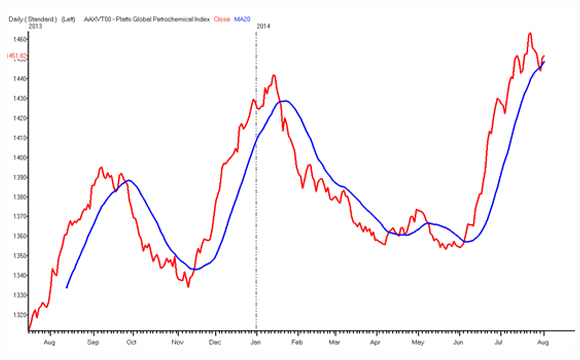Prices in the $3-trillion-plus global petrochemicals market rose for a second consecutive month, up 4% in July to $1,446 per metric ton (/mt), following a 2% monthly advance in June, according to the just-released monthly Platts Global Petrochemical Index (PGPI). The PGPI is a benchmark basket of seven widely used petrochemicals and is published by Platts, a leading global energy, petrochemicals and metals information provider and a top source of benchmark price references. Prices declined in each of the four months prior to June.
On a year-over-year basis, petrochemical prices were up 10% from July 2013. The monthly index last month was at its highest level since February 2013, but came at a time of falling feedstock costs. Crude oil and naphtha prices were down 5% and 2%, respectively in July. Production issues for some products, particularly olefins, put upward pressure on prices. Also, a late June and early July run up in prices helped push the monthly average higher, despite a late-July softening in products prices, such as benzene.
“While prices of some products dropped in line with the lower input costs by late July, it didn’t really show in the full monthly average,” Jim Foster, Platts editorial director of petrochemical analytics. “For example, the average price for benzene in July was $1,445/mt, up from June’s average of $1,385/mt. But notably, the price of benzene started the month on July 1 at $1,470/mt and closed the month at $1,423/mt on July 31.”
PLATTS GLOBAL PETROCHEMICAL INDEX IN DOLLARS PER METRIC TON
The daily price reflected as a monthly average
|
July-‘14 |
Monthly % Change |
Annual % change |
July-‘13 |
June-‘14 |
May-‘14 |
Apr-‘14 |
Mar-‘14 |
|
$1,446 |
4% |
10% |
$1,319 |
$1,387 |
$1,360 |
$1,363 |
$1,371 |

The chart above shows the daily end-of-day Platts Global Petrochemical Index (PGPI) price in red and also displays the 20-day PGPI moving average (MA) in blue. If you have trouble viewing the graphic, visit this link: PGPI Averages.
Petrochemicals are used to make plastic, rubber, nylon and other consumer products and are utilized in manufacturing, construction, pharmaceuticals, aviation, electronics and nearly every commercial industry.
OLEFINS
Prices of olefins – a group of hydrocarbon compounds which are the building blocks to many petrochemical products used to produce everyday goods – were higher in July. Ethylene prices climbed 6% to $1,405/mt, up from $1,320/mt in June. Ethylene spot prices were pushed higher by delayed production start-ups and multiple sales controls implemented by various producers. In the United States, ethylene hit 27-month price highs despite lower naphtha prices. As ethylene prices rose, so did polyethylene, a plastic made from ethylene. The average price of polyethylene globally was $1,711/mt in July, up 3% from $1,661/mt in June.
Propylene prices also rose last month, up 2% to $1,363/mt. This compared to $1,333/mt in June. Polypropylene, a plastic produced from propylene, was up the same percentage to $1,658/mt in July versus a June level of $1,629/mt.
AROMATICS
Prices of aromatics – a group of scented hydrocarbons with benzene rings used to make a variety of petrochemicals – strengthened in July, with paraxylene and toluene tied for largest increase. Both were up 6% month-over-month, with paraxylene prices averaging $1,351/mt versus $1,271/mt in June and toluene prices averaging $1,202/mt in July. Benzene prices were 4% higher at $1,445/mt last month.
The price increases in global petrochemical markets occurred amid a mixed performance by global equity markets in July. The Nikkei 225 rose 3% during the month, the Down Jones Industrial Average fell 1% and the London Stock Exchange Index (FTSE) fell 0.2%.
To access a summary of the July performance of each of the seven key petrochemicals included in the PGPI, visit this link: http://www.platts.com/newsfeature/2014/Petrochemicals/pgpi/index.
The PGPI reflects a compilation of the daily price assessments of physical spot market ethylene, propylene, benzene, toluene, paraxylene, low-density polyethylene (LDPE) and polypropylene as published by Platts and is weighted by the three regions of Asia, Europe and the United States. Used as a price reference, a gauge of sector activity, and a measure of comparison for determining the profitability of selling a barrel of crude oil intact or refining it into products, the PGPI was first published by Platts in August 2007.
Published daily in a real-time news service Platts Petrochemical Alert and other Platts publications, the PGPI is anchored by Platts’ robust and long-established price assessment methodology and the firm’s 100-year history of energy price reporting.
Platts petrochemicals experts are available for media interviews. A sample list of experts may be found at the Platts Media Center. For more information on petrochemicals, visit the Platts website at www.platts.com.




.jpg)


